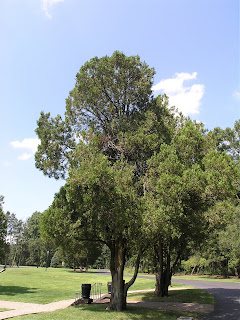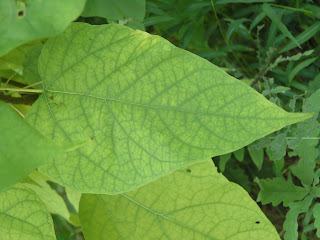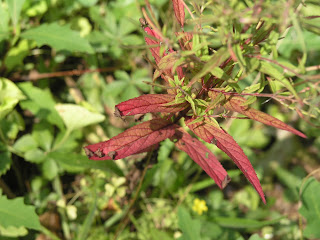
Yesterday I wandered around Duke Farms, the home of the tobacco heiress, Doris Duke, in Somerville, New Jersey. It is now maintained by the Doris Duke Foundation, which has as part of its mission "to be a model of environmental stewardship in the 21st century"

But before I get to pictures there, I passed this tree. In an earlier post I mentioned I had seen pear and cherry trees blooming in August, but I didn't have my camera with me. Well, I came upon another, a flowering crabapple, one of several, all of which had only a handful of leaves left among them.

But on to Duke Farms, where I stopped on the driveway, aghast at the endless array of dead and dying trees.





The magnificent greenhouses are now closed to the public permanently.

Looking in every direction from the parking lot, trees are in dire straits.





Even ground cover like pachysandra shows the classic discoloration that is becoming so familiar.

Perennials like hosta are damaged.

Ditto for lamb's ear.





All these dead and dying trees, and many more I didn't photograph, before I even got to the visitor's center!






There are many pines and cedars in varying states of decline - none are intact.


The azaleas in front of the greenhouse have very few leaves, and those that remain are tiny and reddened.















It's easy to overlook the damage in a forest, and therefore important to took closely at the leaves of even very young trees.







I guess the good news is nasty plants like sumac aren't being spared.


Neither is poison ivy.

Or deadly nightshade.


This is Virginia Creeper, a pretty vine that turns scarlet in the fall.

Random weeds I don't even know the name of are showing signs of toxicity.



Here is the second letter I have sent to the Board of Trustees of the Doris Duke Charitable Foundation.
August 31, 2009
Dear Dr. Henry, Dr. Shaffer, Dr. Bowman, and Dr. Donnelly,
You may recall that I wrote the Board of the Doris Duke Charitable Foundation last February regarding the impact of climate change on trees at the property of Doris Duke's home in Somerville, New Jersey. This was forwarded to and then answered by Gene Huntington, Director, Natural Resources. Our exchange is pasted below.
Mr. Huntington was kind enough to respond with a lengthy discussion of various threats to trees, but more or less ignored my concerns about climate change, preferring to focus instead on disease, age, deer and invasive species. This no longer surprises me because virtually all of the professional foresters and conservationists to whom I have broached this subject react with similar dismissiveness. It was Upton Sinclair of course who observed, "It is difficult to get a man to understand something when his salary depends on his not understanding it."
It is not my intent to disparage Mr. Huntington. I believe he is quite likely a sincere, knowledgeable and dedicated friend of nature. Instead, I am writing because I am convinced it is necessary to take a very hard look at the evidence. We can no longer afford to be romantic about restoring the environment, it is urgently in peril of permanent loss.
Since I last wrote you, the condition of vegetation all along the Eastern Seaboard has deteriorated dramatically, and universally. Thus not only trees, both deciduous and coniferous, but shrubs, annuals, and even weeds are damaged. My understanding of the source has progressed as I have been researching the cause and I now believe it is quite likely that the addition
of ethanol to gasoline, which produces acetaldahyde, a precursor of peroxyacetyl, is the primary toxic component in the atmosphere which is poisoning plants.
Ozone from gas, coal and oil burning is well known to be unhealthful to both plants and humans, and should certainly be curtailed - but the unprecedented rapidity of tree death, and characteristic changes in leaves now prevalent leads me to the conclusion that it is the relatively recently mandated use of ethanol likely to be the major factor...since ozone has been around for decades.
It was not merely a storm that damaged 300 trees in Central Park. They are weakened by the toxic composition of the atmosphere, which causes the stomata in their leaves to close, and in a sense, smothers them.
It is my belief that because the Doris Duke Foundation has a mandate to be a steward for the environment, the Board would be remiss if they did not vigorously pursue what is clearly an existential, imminent threat to the environment which, if unchecked, will lead swiftly to ecosystem collapse and mass extinction. Mr. Huntington closed his message to me, after describing the planting of trees and removal of invasive species at Duke Farms, with this: "Again, thanks for your interest, and we hope this helps at least explain a way in which we are trying to help remedy the insightful situation that you describe."
Although planting native trees and removing invasive species are admirable activities, they are utterly inadequate to address the situation I describe. The remedy is supporting research about the impacts of volatile organic compounds on vegetation, demanding the EPA require the immediate cessation of ethanol additives, and encouraging the rapid deployment of green energy to power plug in vehicles, with the ultimate objective the eradication of all greenhouse gas emissions.
Today I went to Duke Farms in Somerville where I could have easily spent many hours photographing scores of dead and dying trees. I have uploaded some here: witsendnj.blogspot.com where I have also been posting links to peer-reviewed published scientific research on this topic.
I would appreciate it if you would take a look at the blog to see what the trees at Duke Farms actually look like before disregarding my description.
Please feel free to contact me for any reason.
Sincerely,
Gail Zawacki
Oldwick, New Jersey
908-797-3948
Here is the response Mr. Huntington sent me:
--- On Wed, 3/11/09, Gene Huntington
> From: Gene Huntington
> Subject: Condition of trees at the Doris Duke Farm in Somerville
> To: witsendnj@yahoo.com
> Date: Wednesday, March 11, 2009, 1:58 PM
> Dear Ms. Zawacki,
>
>
>
> Your letter of February 28, 2009 was passed to us here at
> Duke Farms to
> begin to address some of your concerns and what we are
> doing about them
> locally. At Duke Farms we consider our trees to be one of
> our greatest
> assets that collectively has been a valued resource for
> over a century
> now. Even when James Buchanan Duke began planting hundreds
> of thousands
> of trees at the turn of the 19th to the 20th century (some
> of them
> invasive to our landscape today that wasn't known or
> appreciated back
> then), there were magnificent trees on the property, some
> of which are
> state champions for the species today, and over 300 years
> old.
>
>
>
> The majority of the trees at Duke Farms are old and in
> decline or are
> known invasive species negatively impacting the health of
> habitats and
> ecosystems. The real predicament is that there is little,
> if any,
> regeneration of young native tree seedlings due to decades
> of
> overbrowsing from an inflated white-tailed deer population.
> We are
> addressing this dilemma by adhering to a stepwise
> "4-Stage Process for
> Habitat and Landscape Regeneration" which we think
> you'll find
> interesting.
>
>
>
> 1) Wildlife Management; FAUNA Paying special
> attention to
> overabundant species that have a negative impact on
> ecosystems/habitat
> (eg. white-tailed deer)
>
> 2) Wildlife Management; FLORA Control of
> invasive plants.
>
> 3) Establish native plant communities This can
> be
> accomplished by allowing the native seed bank to recover
> (if this
> exists) or, as is our case, to plant native plants that are
> known to
> occur locally/regionally.
>
> 4) Monitoring/Follow through, and Maintenance
> This may be
> the most overlooked, yet crucial step, as it protects the
> investment of
> the first three steps. The other steps should not even be
> undertaken
> unless there are resources for monitoring which helps
> determine next
> course of action.
>
>
>
> We have developed this process in cooperation with multiple
> PhD's at
> Rutgers University, most of whom have related research
> projects being
> conducted on the property. We are witnessing encouraging
> progress with
> this process, and it can be implemented at all scales, from
> the
> homeowner to large scale land planning. At Duke Farms,
> last year alone
> we removed invasive plants from dozens of acres,
> regenerated about the
> same amount in acreage with native pollinator meadows, and
> planted about
> 30,000 native trees with the help of volunteers. We intend
> to do the
> same this year and continue the effort into the future, so
> that we can
> demonstrate proper land stewardship in a way that is
> meaningful tour our
> visitors and something they can "take home".
>
>
>
> Again, thanks for your interest, and we hope this helps at
> least explain
> a way in which we are trying to help remedy the insightful
> situation
> that you describe.
>
>
>
> Sincerely,
>
> Gene Huntington
>
> Director, Natural Resources
>
> Duke Farms Foundation
> 80 Route 206
> Hillsborough, NJ 08844
> Cell 908.578.7861
> Desk 908.243.3645
>
> "to be a model of environmental stewardship in the
> 21st century and
> inspire visitors to become informed stewards of the
> land."
> www.dukefarms.org
And here is my response, to which I never received another reply:
Dear Mr. Huntington,
Thank you for your reply and I am glad to know that you are working so assiduously on the landscape at Duke Farms.
I am familiar with the problems you describe and have spent almost 30 years battling invasive species, mainly poisen ivy, bittersweet vines, and the cursed multiflora rose on my 13 acres in Oldwick. Three years ago I put up a deer fence and realized I could have skipped planting so many trees because without the deer, they were coming up all over all by themselves.
However I do beg you to carefully consider what I wrote. It is not only old trees that are in decline. Young trees are also losing their bark and limbs.
Further, the conifers of all ages looked perfectly normal 4 months ago and now it is difficult to find one of any age that is not losing needles at a highly abnormal rate. You can see their trunks, and through to the other side. Evergreen shrubs are also damaged, such as yew, boxwood and rhododendron.
My pet theory for this lately is that it doesn't get cold enough for the trees and shrubs to hibernate, so when we get a cold snap, such as in January and again this last snow storm, the cold damages the leaves/needles of evergreens. I have been watching very closely and the shrubs made steep downturns after each of these weather events.
Another thing I've seen which I never have before, is black streaks down trunks, that look as though the tree is wet even if it's not. I wonder if the sap freezes and expands, cracks the bark, and then starts weeping out as the temperature rises.
Please do me a favor the next couple of days as you go about your routine, and pay attention to the plants and woods around you. I would be very interested to see what you think as I am sure you are a trained observer.
Thank you,
Gail
Hi Gail,
ReplyDeleteEthanol was a big issue in the last election, especially in the midwest. Obama was for ethanol. McCain was against it. Obama won, so you can count on more and more ethanol for at least the next four years.
The Duke Farm looks like a great place. I'd love to volunteer there. How different it would be in design were it created today. Would there be any non-native plantings at all?
Hey Paul,
ReplyDeleteThey used to allow visitors into the greenhouses for a nominal fee, even when she lived there. I brought my kids many times. There were a series of climates, from tropical rain forest to desert to formal rose garden. It was grander than the Conservatory at Golden Gate Park.
For a brief time, after she died, the house was open to tours. She had quite a quirky personality, reflected in her vast collections.
I would love to go to the Foundation property in Hawaii but that would amount to a rather large carbon footprint.
The ethanol lobby is nothing but scary.
Hi Gail,
ReplyDeleteHave you found confirmation for the ethanol/gasoline hazard in Brazil, where they have used ethanol mixed with gasoline as car fuel for many years - at least since the mid 1970ies?.
Brgds Sophie
Hello Sophie, thanks for reminding me to follow up on that. I know Brazil has been using biofuels but I'm not sure whether they are actually using corn-based ethanol, and whether that would make a difference.
ReplyDeleteBut it's definitely worth looking at.